Emission Reduction Potential of Different Types of Finnish Buildings through Energy Retrofits
Abstract
1. Introduction
1.1. Localization of Retrofit Solutions
1.2. Retrofits in Different Building Types
1.3. Other Aspects of Building Retrofits
1.4. Contribution of the Current Study
2. Materials and Methods
2.1. Finnish Building Stock
2.2. Simulation and Optimization
2.3. Building Information—Residential Buildings
2.3.1. Single-Family Houses
2.3.2. Apartment Buildings
2.4. Building Information—Public and Private Service Buildings
2.4.1. Elderly Care Buildings
2.4.2. Office Buildings
2.4.3. Educational Buildings
2.4.4. Commercial Buildings
2.5. Costs and Emissions
3. Results
4. Discussion
4.1. Emission Reduction Potential and Emission Prices
4.2. Benefits of Building Energy Retrofits
4.3. Drivers and Obstacles of Change
4.4. Reliability of Results
5. Conclusions
Author Contributions
Funding
Conflicts of Interest
Abbreviations
| AAHP | Air-to-air heat pump |
| AB | Apartment building |
| AWHP | Air-to-water heat pump |
| Balanced | Mechanical balanced ventilation |
| CAV | Constant air volume ventilation |
| CHP | Combined heat and power |
| DH | District heating |
| EAHP | Exhaust air heat pump |
| ECM | Energy conservation measure |
| EPBD | Energy performance of buildings directive |
| ETS | Emission Trading System |
| Exhaust | Mechanical exhaust ventilation |
| GSHP | Ground-source heat pump |
| HP | Heat pump |
| HR | Heat recovery |
| HX | Heat exchanger |
| LCC | Life cycle cost |
| LED | Light-emitting diode |
| Natural | Natural stack ventilation |
| PV | Solar photovoltaic panel |
| SH | Single-family house |
| ST | Solar thermal collector |
| VAV | Variable air volume |
Appendix A
| - | - | Original | Retrofitted | ||
| Building | Case | DH/Boiler Demand | Electricity Demand | DH/Boiler Demand | Electricity Demand |
| - | - | kWh/m2 | kWh/m2 | kWh/m2 | kWh/m2 |
| AB1 (–1976) | DH | 171.9 | 30.2 | 118.6 | 27.6 |
| AB2 (–2002) | DH | 124.1 | 28.1 | 74.3 | 22.3 |
| AB3 (–2010) | DH | 80.7 | 36.5 | 41.7 | 28.1 |
| AB4 (2010+) | DH | 64.8 | 34.9 | 31.8 | 27.1 |
| AB1 (–1976) | EAHP | 171.9 | 30.2 | 30.8 | 38.8 |
| AB2 (–2002) | EAHP | 124.1 | 28.1 | 31.4 | 34.0 |
| AB1 (–1976) | GSHP | 171.9 | 30.2 | 0 | 48.3 |
| AB2 (–2002) | GSHP | 124.1 | 28.1 | 0 | 32.2 |
| AB3 (–2010) | GSHP | 80.7 | 36.5 | 0 | 40.1 |
| AB4 (2010+) | GSHP | 64.8 | 34.9 | 0 | 35.6 |
| SH1 (–1976) | DH | 234.3 | 20.6 | 76.3 | 26.2 |
| SH2 (–2002) | DH | 177.0 | 23.2 | 83.7 | 36.7 |
| SH3 (–2010) | DH | 148.3 | 28.4 | 76.0 | 33.1 |
| SH4 (2010+) | DH | 115.8 | 26.8 | 71.6 | 34.2 |
| SH1 (–1976) | Oil → GSHP | 280.6 | 20.6 | 0 | 32.8 |
| SH1 (–1976) | Wood → GSHP | 303.0 | 20.6 | 0 | 40.4 |
| SH2 (–2002) | Oil → GSHP | 212.0 | 23.2 | 0 | 33.4 |
| SH2 (–2002) | Wood → GSHP | 228.9 | 23.2 | 0 | 45.0 |
| SH3 (–2010) | Oil → GSHP | 177.6 | 28.4 | 0 | 32.2 |
| SH3 (–2010) | Wood → GSHP | 191.8 | 28.4 | 0 | 41.1 |
| SH4 (2010+) | Oil → GSHP | 138.7 | 26.8 | 0 | 33.3 |
| SH4 (2010+) | Wood → GSHP | 149.8 | 26.8 | 0 | 38.7 |
| SH1 (–1976) | Wood → Wood | 303.0 | 20.6 | 103.9 | 35.3 |
| SH2 (–2002) | Wood → Wood | 228.9 | 23.2 | 129.7 | 38.5 |
| SH3 (–2010) | Wood → Wood | 191.8 | 28.4 | 123.9 | 38.7 |
| SH4 (2010+) | Wood → Wood | 149.8 | 26.8 | 100.3 | 31.6 |
| SH1 (–1976) | Elec | 0.0 | 233.4 | 0 | 81.6 |
| SH2 (–2002) | Elec | 0.0 | 179.5 | 0 | 70.7 |
| SH3 (–2010) | Elec | 0.0 | 169.5 | 0 | 67.8 |
| SH4 (2010+) | Elec | 0.0 | 140.8 | 0 | 62.4 |
| Office | DH | 169.6 | 44.3 | 33.7 | 34.1 |
| Office | GSHP | 169.6 | 44.3 | 0.2 | 43.9 |
| Elderly | DH | 253.9 | 58.6 | 75.6 | 44.2 |
| Elderly | AWHP | 253.9 | 58.6 | 0 | 62.5 |
| Commercial | DH, neutral | 68.6 | 118.4 | 68.6 | 47.4 |
| Commercial | GSHP, neutral | 68.6 | 118.4 | 4.5 | 67.6 |
| Commercial | DH, min cost | 68.6 | 118.4 | 68.6 | 69.8 |
| Commercial | GSHP, min cost | 68.6 | 118.4 | 4.5 | 91.1 |
| Educational | DH | 222.1 | 46.6 | 77.7 | 27.4 |
| Educational | GSHP | 222.1 | 46.6 | 55.9 | 26.3 |
References
- European Parliament. Directive 2010/31/EU of the European Parliament and of the Council of 19 May 2010 on the energy performance of buildings. Off. J. Eur. Union 2010, 153, 13–35. [Google Scholar]
- Yücel, G. Extent of inertia caused by the existing building stock against an energy transition in the Netherlands. Energy Build. 2013, 56, 134–145. [Google Scholar] [CrossRef]
- European Parliament. Directive (EU) 2018/844 of the European Parliament and of the Council amending Directive 2010/31/EU on the energy performance of buildings and Directive 2012/27/EU on the energy efficiency. Off. J. Eur. Union 2018, 156, 75–91. [Google Scholar]
- European Commission. A Renovation Wave for Europe—Greening our Buildings, Creating Jobs, Improving Lives; European Commission: Brussels, Belgium, 14 October 2020. [Google Scholar]
- Saikia, P.; Pancholi, M.; Sood, D.; Rakshit, D. Dynamic optimization of multi-retrofit building envelope for enhanced energy performance with a case study in hot Indian climate. Energy 2020, 197, 117263. [Google Scholar] [CrossRef]
- Sarihi, S.; Saradj, F.M.; Faizi, M. A Critical Review of Façade Retrofit Measures for Minimizing Heating and Cooling Demand in Existing Buildings. Sustain. Cities Soc. 2021, 64, 102525. [Google Scholar] [CrossRef]
- Fan, Y.; Xia, X. A multi-objective optimization model for energy-efficiency building envelope retrofitting plan with rooftop PV system installation and maintenance. Appl. Energy 2017, 189, 327–335. [Google Scholar] [CrossRef]
- Rakhshan, K.; Friess, W.A. Effectiveness and viability of residential building energy retrofits in Dubai. J. Build. Eng. 2017, 13, 116–126. [Google Scholar] [CrossRef]
- Guillén-Lambea, S.; Rodríguez-Soria, B.; Marín, J.M. Air infiltrations and energy demand for residential low energy buildings in warm climates. Renew. Sustain. Energy Rev. 2019, 116, 109469. [Google Scholar] [CrossRef]
- Shao, Y.; Geyer, P.; Lang, W. Integrating requirement analysis and multi-objective optimization for office building energy retrofit strategies. Energy Build. 2014, 82, 356–368. [Google Scholar] [CrossRef]
- Foda, E.; El-Hamalawi, A.; Le Dréau, J. Computational analysis of energy and cost efficient retrofitting measures for the French house. Build. Environ. 2020, 175, 106792. [Google Scholar] [CrossRef]
- Rogeau, A.; Girard, R.; Abdelouadoud, Y.; Thorel, M.; Kariniotakis, G. Joint optimization of building-envelope and heating-system retrofits at territory scale to enhance decision-aiding. Appl. Energy 2020, 264, 114639. [Google Scholar] [CrossRef]
- La Fleur, L.; Rohdin, P.; Moshfegh, B. Investigating cost-optimal energy renovation of a multifamily building in Sweden. Energy Build. 2019, 203, 109438. [Google Scholar] [CrossRef]
- Milić, V.; Ekelöw, K.; Andersson, M.; Moshfegh, B. Evaluation of energy renovation strategies for 12 historic building types using LCC optimization. Energy Build. 2019, 197, 156–170. [Google Scholar] [CrossRef]
- Hirvonen, J.; Jokisalo, J.; Heljo, J.; Kosonen, R. Towards the EU Emission Targets of 2050: Cost-Effective Emission Reduction in Finnish Detached Houses. Energies 2019, 12, 4395. [Google Scholar] [CrossRef]
- Niemelä, T.; Kosonen, R.; Jokisalo, J. Cost-effectiveness of energy performance renovation measures in Finnish brick apartment buildings. Energy Build. 2017, 137, 60–75. [Google Scholar] [CrossRef]
- Niemelä, T.; Kosonen, R.; Jokisalo, J. Energy performance and environmental impact analysis of cost-optimal renovation solutions of large panel apartment buildings in Finland. Sustain. Cities Soc. 2017, 32, 9–30. [Google Scholar] [CrossRef]
- Dodoo, A. Techno-economic and environmental performances of heating systems for single-family code-compliant and passive houses. E3S Web Conf. 2019, 111, 03039. [Google Scholar] [CrossRef]
- Hirvonen, J.; Jokisalo, J.; Kosonen, R. The Effect of Deep Energy Retrofit on The Hourly Power Demand of Finnish Detached Houses. Energies 2020, 13, 1773. [Google Scholar] [CrossRef]
- Asaee, S.R.; Nikoofard, S.; Ugursal, V.I.; Beausoleil-Morrison, I. Techno-economic assessment of photovoltaic (PV) and building integrated photovoltaic/thermal (BIPV/T) system retrofits in the Canadian housing stock. Energy Build. 2017, 152, 667–679. [Google Scholar] [CrossRef]
- Asaee, S.R.; Ugursal, V.I.; Beausoleil-Morrison, I. Techno-economic feasibility evaluation of air to water heat pump retrofit in the Canadian housing stock. Appl. Therm. Eng. 2017, 111, 936–949. [Google Scholar] [CrossRef]
- Salata, F.; Ciancio, V.; Dell’Olmo, J.; Golasi, I.; Palusci, O.; Coppi, M. Effects of local conditions on the multi-variable and multi-objective energy optimization of residential buildings using genetic algorithms. Appl. Energy 2020, 260, 114289. [Google Scholar] [CrossRef]
- IEA. France—Countries & Regions. IEA Data Browser, France. 2020. Available online: https://www.iea.org/countries/france (accessed on 15 September 2020).
- IEA. Germany—Countries & Regions. IEA Data Browser, Germany. 2020. Available online: https://www.iea.org/countries/germany (accessed on 15 September 2020).
- Prabatha, T.; Hewage, K.; Karunathilake, H.; Sadiq, R. To retrofit or not? Making energy retrofit decisions through life cycle thinking for Canadian residences. Energy Build. 2020, 226, 110393. [Google Scholar] [CrossRef]
- Niemelä, T.; Levy, K.; Kosonen, R.; Jokisalo, J. Cost-optimal renovation solutions to maximize environmental performance, indoor thermal conditions and productivity of office buildings in cold climate. Sustain. Cities Soc. 2017, 32, 417–434. [Google Scholar] [CrossRef]
- Papadopoulos, S.; Kontokosta, C.E.; Vlachokostas, A.; Azar, E. Rethinking HVAC temperature setpoints in commercial buildings: The potential for zero-cost energy savings and comfort improvement in different climates. Build. Environ. 2019, 155, 350–359. [Google Scholar] [CrossRef]
- Bienvenido-Huertas, D.; Sánchez-García, D.; Pérez-Fargallo, A.; Rubio-Bellido, C. Optimization of energy saving with adaptive setpoint temperatures by calculating the prevailing mean outdoor air temperature. Build. Environ. 2020, 170, 106612. [Google Scholar] [CrossRef]
- Zheng, L.; Lai, J.H. Environmental and economic evaluations of building energy retrofits: Case study of a commercial building. Build. Environ. 2018, 145, 14–23. [Google Scholar] [CrossRef]
- Güçyeter, B.; Gunaydin, H.M.; Günaydın, H.M. Optimization of an envelope retrofit strategy for an existing office building. Energy Build. 2012, 55, 647–659. [Google Scholar] [CrossRef]
- Ascione, F.; Bianco, N.; Iovane, T.; Mauro, G.M.; Napolitano, D.F.; Ruggiano, A.; Viscido, L. A real industrial building: Modeling, calibration and Pareto optimization of energy retrofit. J. Build. Eng. 2020, 29, 101186. [Google Scholar] [CrossRef]
- Ascione, F.; Bianco, N.; De Stasio, C.; Mauro, G.M.; Vanoli, G.P. Multi-stage and multi-objective optimization for energy retrofitting a developed hospital reference building: A new approach to assess cost-optimality. Appl. Energy 2016, 174, 37–68. [Google Scholar] [CrossRef]
- Webb, A.L. Energy retrofits in historic and traditional buildings: A review of problems and methods. Renew. Sustain. Energy Rev. 2017, 77, 748–759. [Google Scholar] [CrossRef]
- Carlson, K.; Pressnail, K.D. Value impacts of energy efficiency retrofits on commercial office buildings in Toronto, Canada. Energy Build. 2018, 162, 154–162. [Google Scholar] [CrossRef]
- Azizi, S.; Nair, G.; Olofsson, T. Analysing the house-owners’ perceptions on benefits and barriers of energy renovation in Swedish single-family houses. Energy Build. 2019, 198, 187–196. [Google Scholar] [CrossRef]
- Bjørneboe, M.G.; Svendsen, S.; Heller, A. Evaluation of the renovation of a Danish single-family house based on measurements. Energy Build. 2017, 150, 189–199. [Google Scholar] [CrossRef]
- Hirvonen, J.; Jokisalo, J.; Heljo, J.; Kosonen, R. Towards the EU emissions targets of 2050: Optimal energy renovation measures of Finnish apartment buildings. Int. J. Sustain. Energy 2019, 38, 649–672. [Google Scholar] [CrossRef]
- Jokisalo, J.; Sankelo, P.; Vinha, J.; Sirén, K.; Kosonen, R. Cost optimal energy performance renovation measures in a municipal service building in a cold climate. E3S Web Conf. 2019, 111, 03022. [Google Scholar] [CrossRef]
- Niemelä, T.; Kosonen, R.; Jokisalo, J. Cost-optimal energy performance renovation measures of educational buildings in cold climate. Appl. Energy 2016, 183, 1005–1020. [Google Scholar] [CrossRef]
- Saari, A.; Airaksinen, M. Energiatehokkuutta Koskevien Vähimmäisvaatimusten Kustannusoptimaalisten Tasojen Laskenta; EU Commission: Espoo, Finland, 2012. (In Finnish) [Google Scholar]
- Statistics Finland. Buildings by Area, Heating Fuel/Source of Heat, Intended Use of Building and Information. PxWeb. 2017. Available online: http://pxnet2.stat.fi/PXWeb/pxweb/en/StatFin_Passiivi/StatFin_Passiivi__asu__rakke/statfinpas_rakke_pxt_002_201700.px/table/tableViewLayout1/ (accessed on 30 June 2020).
- EQUA Simulation AB. IDA ICE—Simulation Software. 2019. Available online: https://www.equa.se/en/ida-ice (accessed on 8 August 2019).
- Vadiee, A.; Dodoo, A.; Gustavsson, L. A Comparison Between Four Dynamic Energy Modeling Tools for Simulation of Space Heating Demand of Buildings. In Cold Climate HVAC 2018; Springer: Cham, Switzerland, 2019; pp. 701–711. [Google Scholar]
- EQUA Simulation AB. Validation of IDA Indoor Climate and Energy 4.0 with Respect to CEN Standards EN 15255-2007 and EN 15265-2007; EQUA Simulation AB: Solna, Sweden, 2010. [Google Scholar]
- Loutzenhiser, P.; Manz, H.; Maxwell, G. Empirical Validations of Shading/Daylighting/Load Interactions in Building Energy Simulation Tools; IEA—International Energy Agency: Paris, France, 2007. [Google Scholar]
- Palonen, M.; Hamdy, M.; Hasan, A. MOBO a new software for multi-objective building performance optimization. In Proceedings of the 13th Conference of International Building Performance Simulation Association, Chambéry, France, 26–28 August 2013. [Google Scholar]
- Deb, K.; Pratap, A.; Agarwal, S.; Meayarivan, T. A fast and elitist multiobjective genetic algorithm: NSGA-II. IEEE Trans. Evolut. Comput. 2002, 6, 182–197. [Google Scholar] [CrossRef]
- Lehtinen, T. Rakennuksen Energiankulutuksen ja Lämmitystehon Tarpeen Laskenta [The Calculation of Energy Consumption and Heating Power Demand]; Ministry of the Environment: Helsinki, Finland, 20 December 2017. (In Finnish) [Google Scholar]
- Hirvonen, J.; Jokisalo, J.; Heljo, V.J.; Kosonen, R. Effect of apartment building energy renovation on hourly power demand. Int. J. Sustain. Energy 2019, 38, 918–936. [Google Scholar] [CrossRef]
- Fortum Oy. Kaukolämmön hinnat pientaloille, (District Heating Prices for Detached Houses). Available online: https://www.fortum.fi/kotiasiakkaille/lammitys/kaukolampo/kaukolammon-hinnat-pientaloille (accessed on 23 June 2020).
- Fortum Oy. Kaukolämmön hinnat taloyhtiöille ja yrityksille, (District Heating Prices for Companies). 2020. Available online: https://www.fortum.fi/yrityksille-ja-yhteisoille/lammitys-ja-jaahdytys/kaukolampo/kaukolammon-hinnat-taloyhtioille-ja-yrityksille (accessed on 23 June 2020).
- Helen Oy. Sähkön siirtohinnat Helsingissä (Electricity distribution prices in Helsinki). 2020. Available online: https://www.helensahkoverkko.fi/palvelut/hinnastot (accessed on 23 June 2020).
- Nord Pool. Historical Electricity Market Data. 2018. Available online: https://www.nordpoolgroup.com/historical-market-data/ (accessed on 14 January 2020).
- Statistics Finland. Fuel Classification 2019; Statistics Finland: Helsinki, Finland, 2019. (In Finnish) [Google Scholar]
- Motiva Oy. CO2 Emission Factors in Finland; Motiva Oy: Helsinki, Finland, 2019. (In Finnish) [Google Scholar]
- Finnish Energy. Emission Factors of Finnish Electricity, Email Contact; Finnish Energy: Helsinki, Finland, 2017. [Google Scholar]
- Statistics Finland. Buildings and Gross Floor Area of Finnish Building Stock by Building Type. Tilastokeskuksen PX-Web Tietokannat. 2019. Available online: http://pxnet2.stat.fi/PXWebPXWeb/pxweb/en/StatFin/StatFin__asu__rakke/statfin_rakke_pxt_116g.px/. (accessed on 22 September 2020).
- Ministry of the Environment. Pitkän Aikavälin Korjausrakentamisen Strategia 2020–2050; Ministry of the Environment: Helsinki, Finland, 2020. (In Finnish) [Google Scholar]
- Motiva Oy. Rakentaminen ja rakennukset. Motiva. Available online: https://www.motiva.fi/julkinen_sektori/kestavat_julkiset_hankinnat/tietopankki/rakentaminen_ja_rakennukset (accessed on 22 September 2020).
- Verohallinto. Nestemäisten Polttoaineiden Verotaulukot. Verohallinto. Available online: https://www.vero.fi/yritykset-ja-yhteisot/tietoa-yritysverotuksesta/valmisteverotus/nestemaiset_polttoaineet/nestemaisten_polttoaineiden_verotaulukk/ (accessed on 10 March 2020).
- Taimiteko. Taimiteko [The Planting Deed]. Taimiteko. Available online: https://www.taimiteko.fi/info/ (accessed on 10 March 2020).
- Haverinen-Shaughnessy, U.; Pekkonen, M.; Leivo, V.; Prasauskas, T.; Turunen, M.; Kiviste, M.; Aaltonen, A.; Martuzevicius, D. Occupant satisfaction with indoor environmental quality and health after energy retrofits of multi-family buildings: Results from INSULAtE-project. Int. J. Hyg. Environ. Health 2018, 221, 921–928. [Google Scholar] [CrossRef] [PubMed]
- Lan, L.; Wargocki, P.; Lian, Z. Quantitative measurement of productivity loss due to thermal discomfort. Energy Build. 2011, 43, 1057–1062. [Google Scholar] [CrossRef]
- Hardcastle, J.L. How to Boost Brand Value, Sales from GHG Management; Environment + Energy Leader: Fort Collins, CO, USA, 2017; Available online: https://www.environmentalleader.com/2017/02/boost-brand-value-sales-ghg-management/ (accessed on 12 June 2020).
- Rämä, M.; Niemi, R.; Similä, L. Exhaust Air Heat Pumps in a District Heating System (Poistoilmalämpöpumput Kaukolämpöjärjestelmässä); VTT-CR-00564-15; VTT Technical Research Center of Finland: Espoo, Finland, 2015. (In Finnish) [Google Scholar]
- Helin, K.; Syri, S.; Zakeri, B. Improving district heat sustainability and competitiveness with heat pumps in the future Nordic energy system. Energy Procedia 2018, 149, 455–464. [Google Scholar] [CrossRef]
- ARA. Energy Assistance 2020 (Energia-Avustukset 2020). 2019. Available online: https://www.ara.fi/fi-FI/Lainat_ja_avustukset/Energiaavustus (accessed on 22 October 2020). (In Finnish).
- Ministry of the Environment. Staggering of the Property Tax of Buildings according to Energy Efficiency and heating System (Rakennusten kiinteistöveron porrastaminen energiatehokkuuden ja lämmitystavan perusteella); Ministry of the Environment: Helsinki, Finland, 2009. (In Finnish) [Google Scholar]
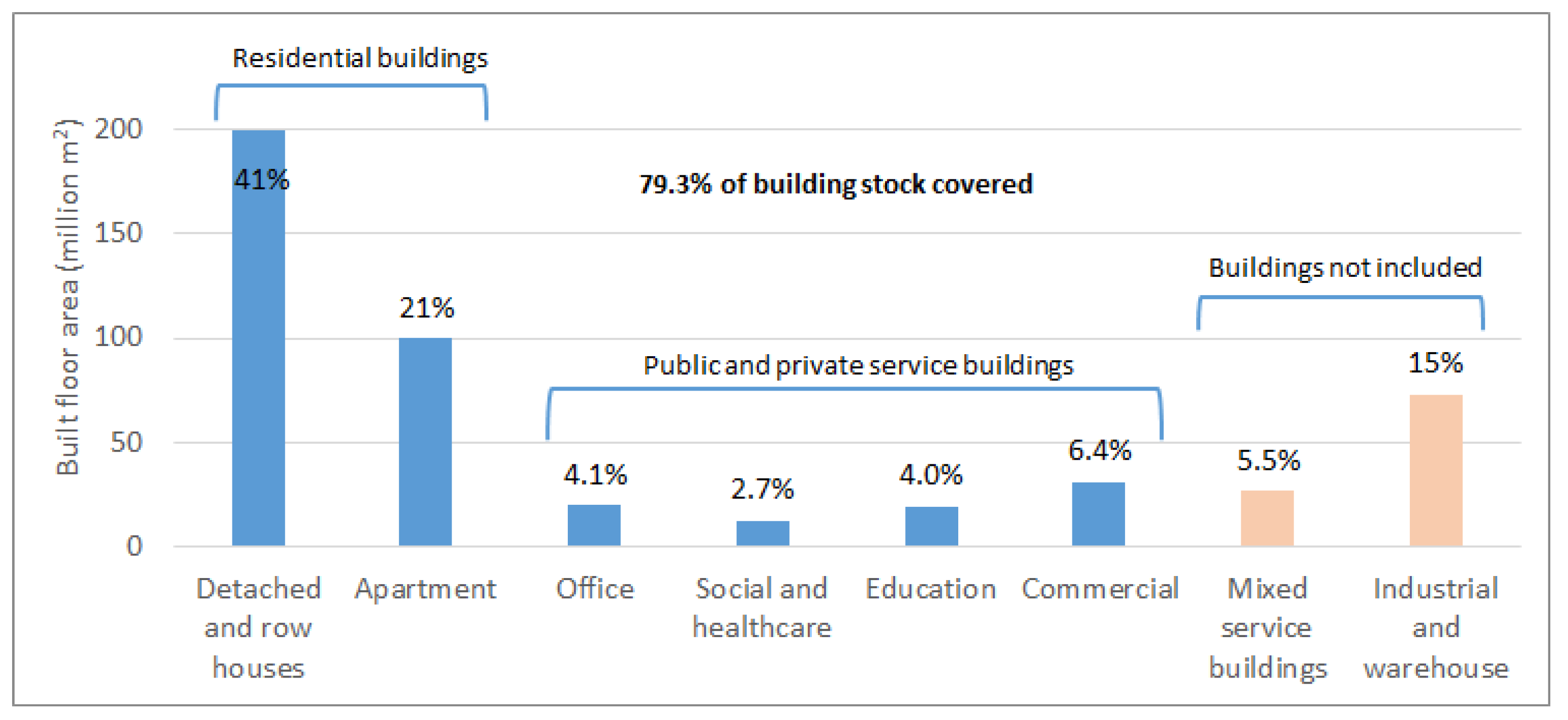
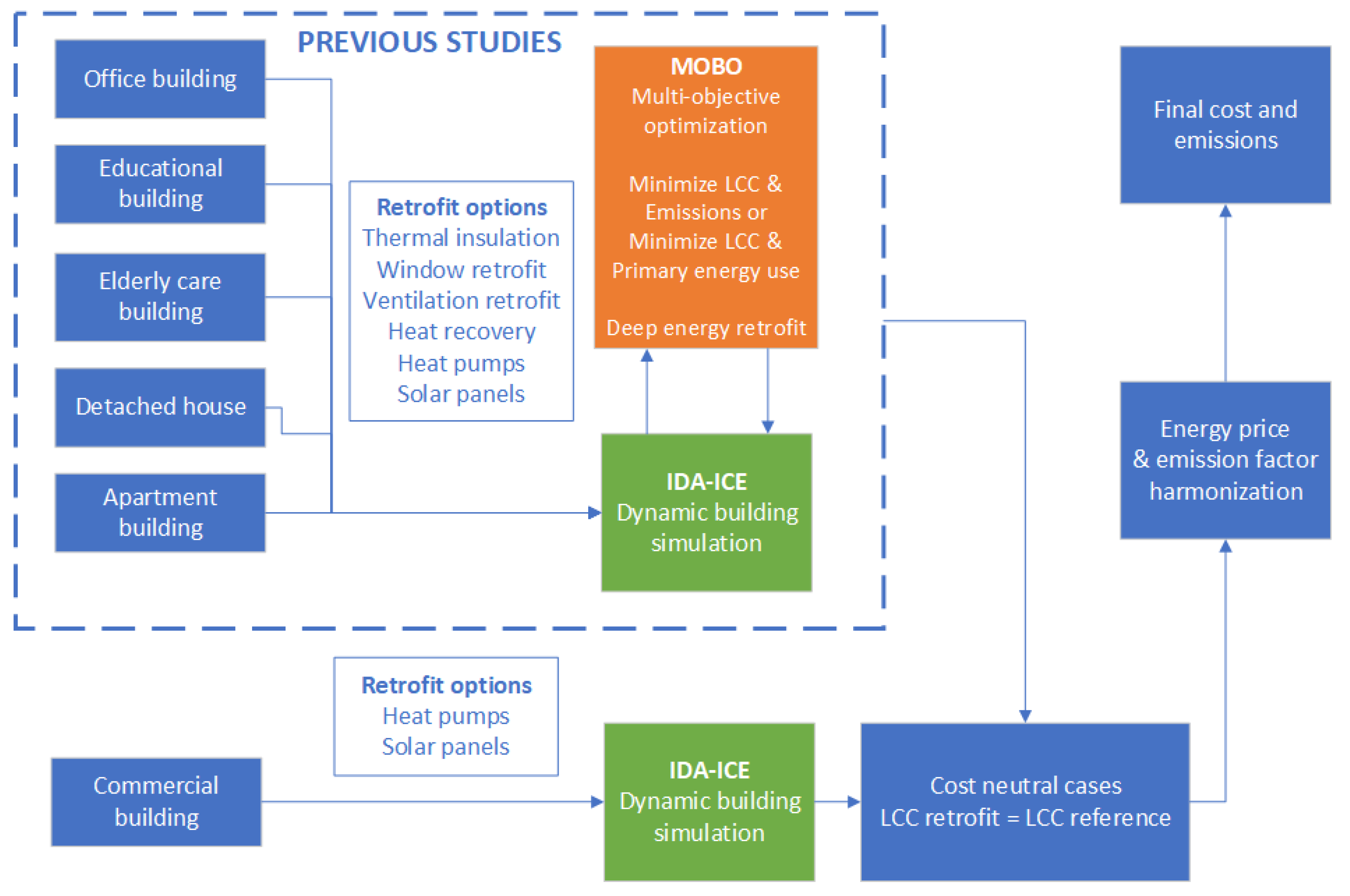
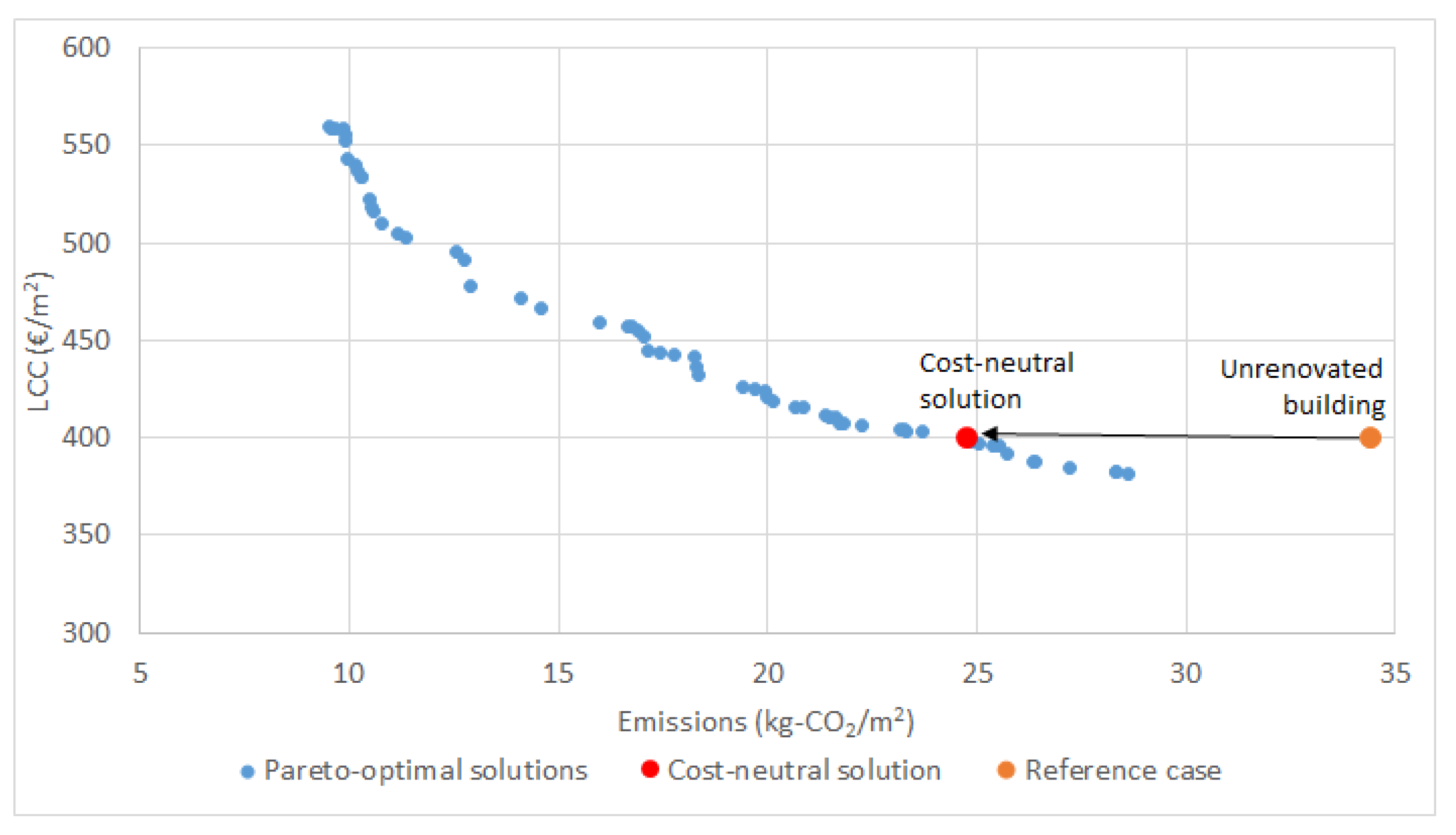
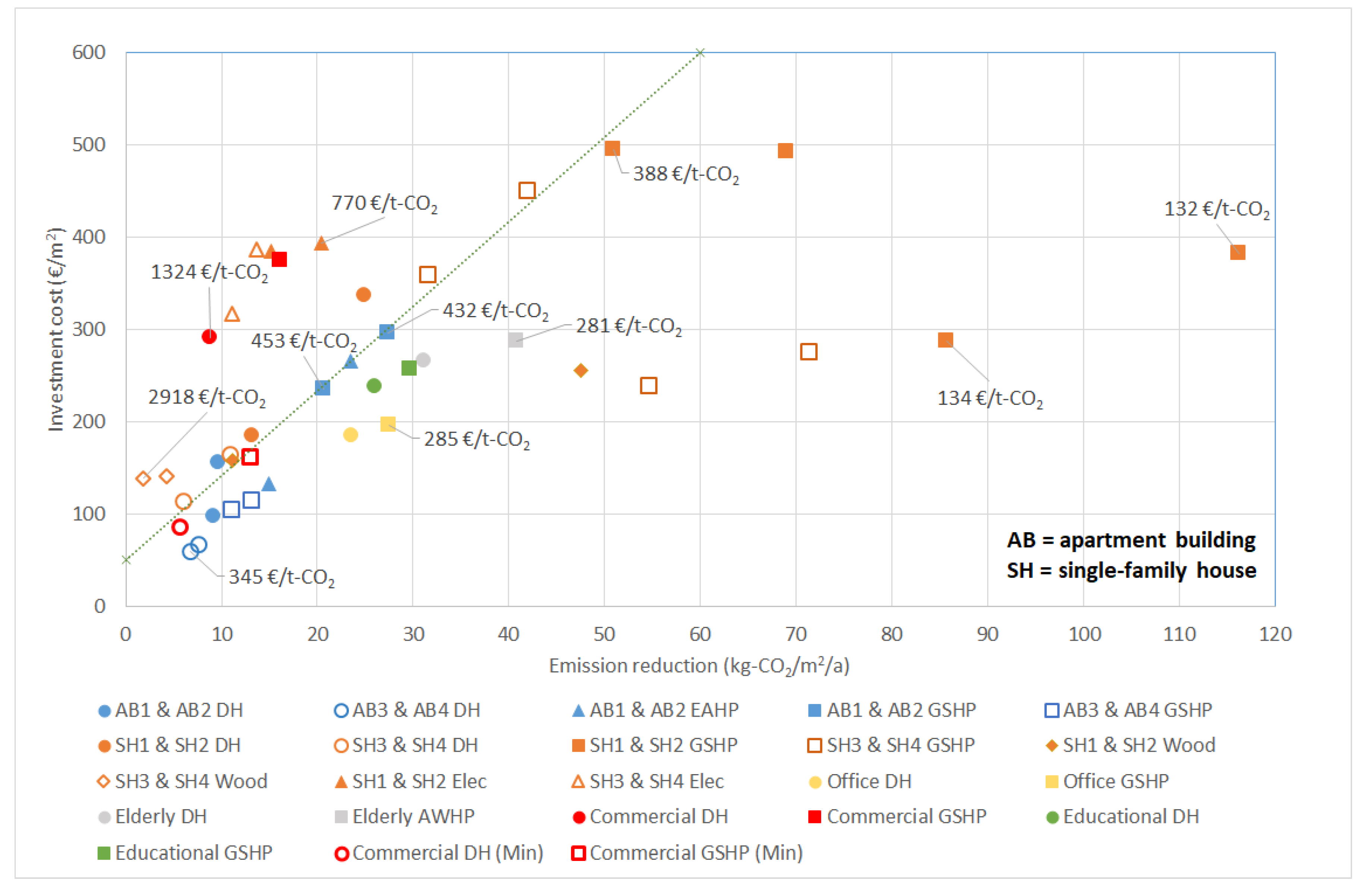
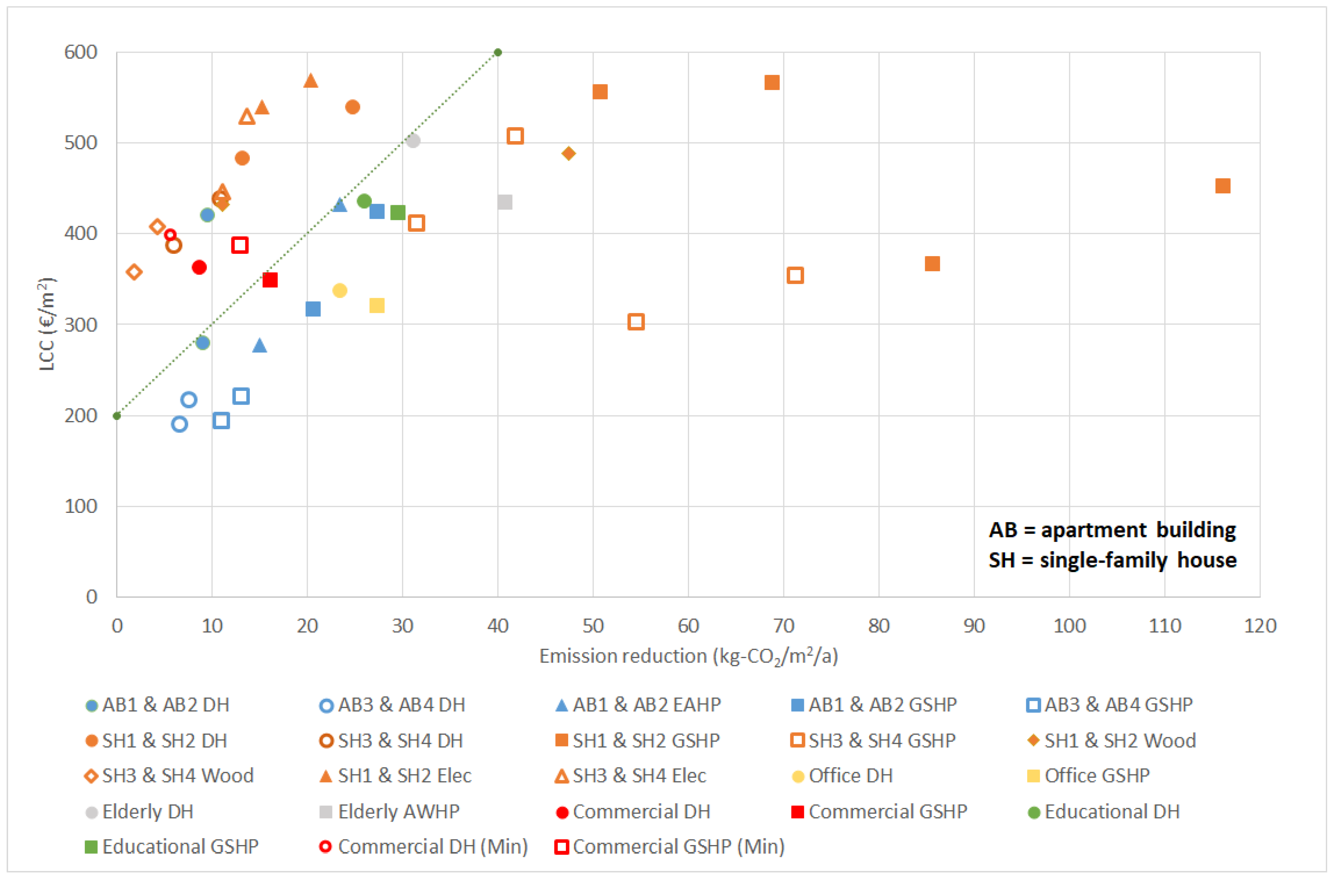
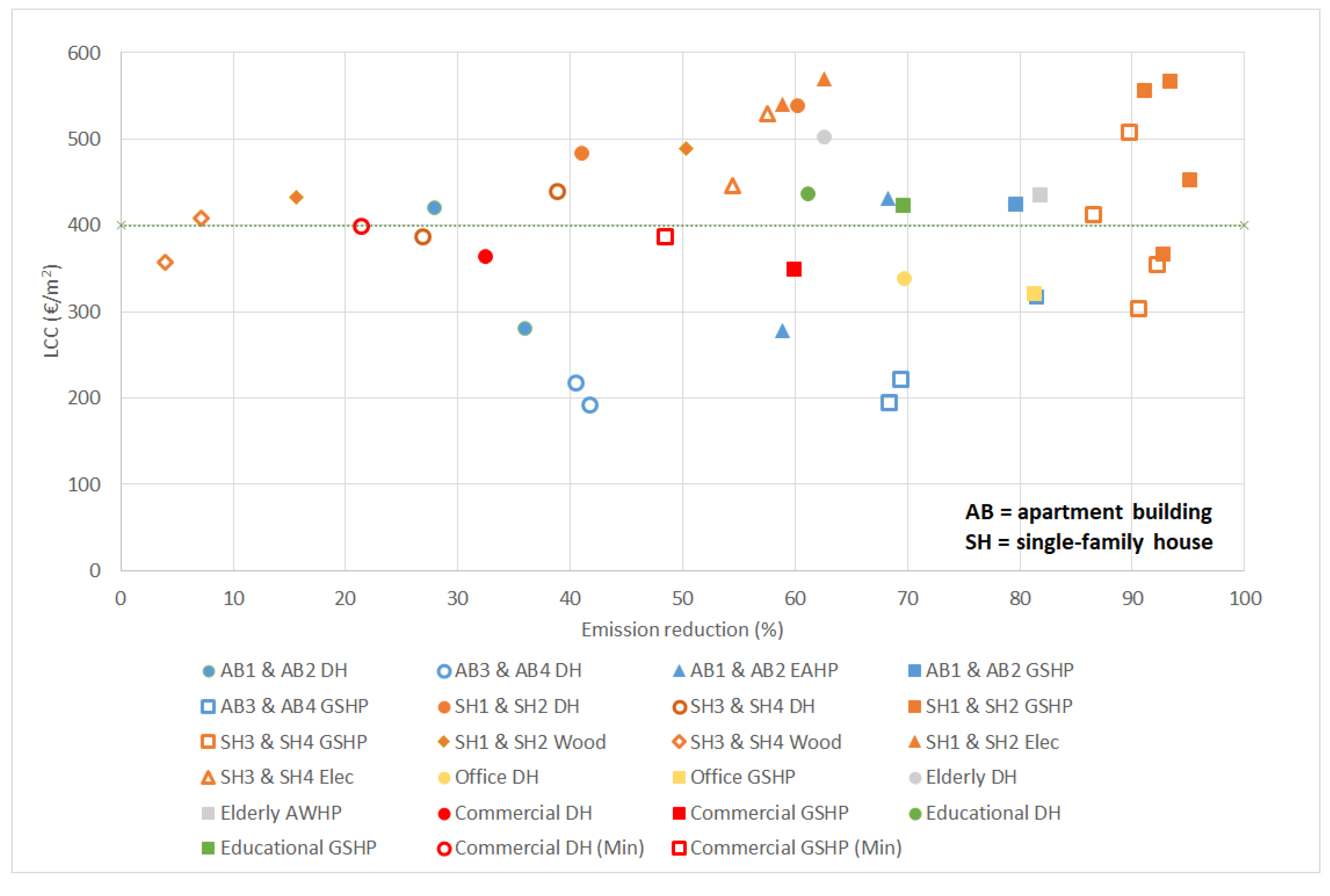
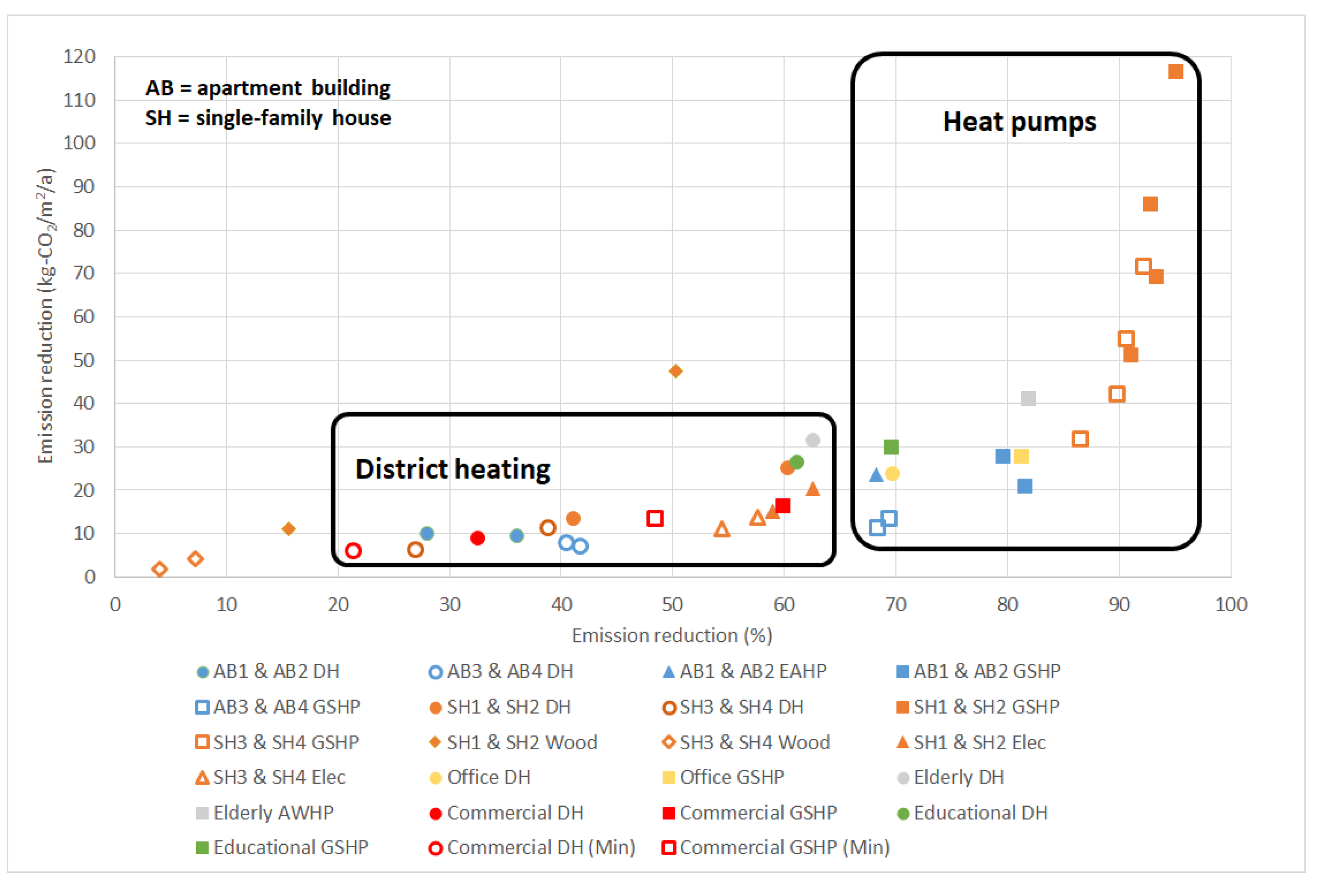
| - | - | Building Envelope | Building Service Systems | ||||||||
|---|---|---|---|---|---|---|---|---|---|---|---|
| Building | Heating System | Walls | Roof | Doors | Windows | Ventilation | Radiator | GSHP | AAHP | PV | ST |
| - | - | W/m2 K | (HR eff) | °C/°C | kWth | kWth | kW | m2 | |||
| SH1 | DH | 0.12 | 0.1 | 1.4 | 1 | Natural (0%) | 70/40 | 0 | 6 | 9 | 8 |
| SH2 | DH | 0.12 | 0.08 | 1.4 | 1.6 | Exhaust (0%) | 70/40 | 0 | 3 | 0 | 8 |
| SH3 | DH | 0.17 | 0.08 | 1.4 | 1.4 | Balanced, VAV (55%) | 45/35 | 0 | 5 | 1 | 6 |
| SH4 | DH | 0.17 | 0.09 | 1 | 1 | Balanced, VAV (65%) | 45/35 | 0 | 3 | 0 | 4 |
| SH1 | Oil → GSHP | 0.1 | 0.09 | 1 | 0.6 | Natural (0%) | 45/35 | 8 | 0 | 6 | 20 |
| SH1 | Wood → GSHP | 0.2 | 0.12 | 1.4 | 0.6 | Natural (0%) | 45/35 | 7 | 0 | 10 | 0 |
| SH2 | Oil → GSHP | 0.08 | 0.09 | 1 | 0.6 | Exhaust (0%) | 45/35 | 12 | 0 | 8 | 18 |
| SH2 | Wood → GSHP | 0.19 | 0.09 | 1.4 | 1.6 | Exhaust (0%) | 45/35 | 7 | 0 | 10 | 2 |
| SH3 | Oil → GSHP | 0.08 | 0.08 | 1 | 0.6 | Balanced, VAV (75%) | 45/35 | 6 | 0 | 8 | 16 |
| SH3 | Wood → GSHP | 0.14 | 0.09 | 1.4 | 1.4 | Balanced, VAV (75%) | 45/35 | 7 | 0 | 9 | 0 |
| SH4 | Oil → GSHP | 0.08 | 0.08 | 0.8 | 1 | Balanced, VAV (75%) | 45/35 | 14 | 0 | 9 | 10 |
| SH4 | Wood → GSHP | 0.11 | 0.09 | 1 | 1 | Balanced, VAV (65%) | 45/35 | 5 | 0 | 10 | 0 |
| SH1 | Wood | 0.12 | 0.09 | 1 | 1.8 | Natural (0%) | 70/40 | 0 | 5 | 0 | 12 |
| SH2 | Wood | 0.19 | 0.1 | 1.4 | 1.6 | Exhaust (0%) | 70/40 | 0 | 3 | 0 | 4 |
| SH3 | Wood | 0.25 | 0.09 | 1.4 | 1.4 | Balanced, VAV (55%) | 45/35 | 0 | 3 | 0 | 2 |
| SH4 | Wood | 0.17 | 0.09 | 1 | 1 | Balanced, VAV (65%) | 45/35 | 0 | 1 | 0 | 4 |
| SH1 | Elec | 0.1 | 0.09 | 0.8 | 0.6 | Natural (0%) | 70/40 | 0 | 3 | 8 | 18 |
| SH2 | Elec | 0.08 | 0.08 | 0.8 | 0.6 | Exhaust (0%) | 70/40 | 0 | 4 | 7 | 20 |
| SH3 | Elec | 0.1 | 0.07 | 0.8 | 0.6 | Balanced, VAV (75%) | 45/35 | 0 | 4 | 8 | 18 |
| SH4 | Elec | 0.07 | 0.08 | 1 | 1 | Balanced, VAV (75%) | 45/35 | 0 | 4 | 8 | 18 |
| - | - | Building Envelope | Building Service Systems | ||||||||||
|---|---|---|---|---|---|---|---|---|---|---|---|---|---|
| Building | Heating System | Walls | Roof | Doors | Windows | Ventilation System and Control | Radiator Temp | GSHP/ EAHP | Backup Heating | Sewage HR | PV | ST | |
| - | - | W/m2K | (HR eff) | - | °C/°C | kWth | kW | - | kW | m2 | |||
| AB1 | DH | 0.81 | 0.08 | 2.2 | 0.7 | Exhaust (0%) | CAV | 70/40 | - | - | HP | 30 | 55 |
| AB2 | DH | 0.34 | 0.26 | 0.7 | 1 | Exhaust (0%) | CAV | 70/40 | - | - | HX | 25 | 100 |
| AB3 | DH | 0.25 | 0.07 | 1.4 | 1.4 | Balanced (60%) | VAV | 70/40 | - | - | HX | 15 | 50 |
| AB4 | DH | 0.17 | 0.09 | 1 | 1 | Balanced (65%) | VAV | 45/35 | - | - | HX | 15 | 45 |
| AB1 | EAHP | 0.23 | 0.1 | 1 | 0.8 | Exhaust (0%) | CAV | 70/40 | 35 | DH | HP | 40 | 0 |
| AB2 | EAHP | 0.34 | 0.26 | 0.7 | 0.6 | Exhaust (0%) | CAV | 70/40 | 25 | DH | HP | 45 | 35 |
| AB1 | GSHP | 0.36 | 0.08 | 0.7 | 0.7 | Exhaust (0%) | CAV | 45/35 | 110 | Electric | HP | 35 | 60 |
| AB2 | GSHP | 0.34 | 0.26 | 1.4 | 0.7 | Exhaust (0%) | CAV | 65/40 | 35 | Electric | HP | 35 | 25 |
| AB3 | GSHP | 0.25 | 0.06 | 0.7 | 1.4 | Balanced (60%) | VAV | 70/40 | 25 | Electric | HX | 20 | 60 |
| AB4 | GSHP | 0.17 | 0.09 | 1 | 1 | Balanced (65%) | VAV | 45/35 | 25 | Electric | HX | 25 | 30 |
| - | - | Building Envelope | Building Service Systems | ||||||||
|---|---|---|---|---|---|---|---|---|---|---|---|
| Building | Heating System | Walls | Roof | Windows | Ventilation System & Control | GSHP/AWHP | Backup Heating | PV | ST | Other | |
| - | - | W/m2K | (HR eff) | kWth | kW | m2 | |||||
| Elderly | DH | 0.27 | 0.08 | 0.6 | Balanced (72%) | CAV, sched | - | - | 95 | 119 | automated lights |
| Elderly | AWHP | 0.17 | 0.08 | 0.5 | Balanced (72%) | CAV, sched | 175 (81%) | Electric | 153 | 118 | automated lights |
| Educational | DH | 0.54 | 0.17 | 1 | Balanced (77%) | CAV, sched | - | - | 347 | 168 | |
| Educational | GSHP | 0.54 | 0.09 | 0.7 | Balanced (77%) | CAV, sched | 42 (3.3%) | DH | 484 | 0 | - |
| Office | DH | 0.35 | 0.1 | 0.6 | Balanced (77%) | VAV, CO2 + T | - | - | 74 | 0 | LED |
| Office | GSHP | 0.35 | 0.29 | 0.7 | Balanced (77%) | VAV, CO2 + T | 276 (104%) | DH | 76 | 0 | LED, automated lights |
| Commercial | DH, cost-neutral | 0.28 | 0.22 | 1.4 | Balanced (60%) | CAV, sched | - | - | 620 | 0 | - |
| Commercial | GSHP, cost-neutral | 0.28 | 0.22 | 1.4 | Balanced (60%) | CAV, sched | 121 (67%) | DH | 650 | 0 | - |
| Commercial | DH, min cost | 0.28 | 0.22 | 1.4 | Balanced (60%) | CAV, sched | - | - | 180 | 0 | - |
| Commercial | GSHP, min cost | 0.28 | 0.22 | 1.4 | Balanced (60%) | CAV, sched | 121 (67%) | DH | 195 | 0 | - |
| Building | SH | Elder, AB, Office GSHP | Commercial, Office DH | AB1 DH | Educational |
|---|---|---|---|---|---|
| Capacity cost (€/kW + €) | 5.15 × PDH − 6.1 | 53 × PDH − 60 | 38 × PDH + 1220 | 36 × PDH + 3000 | 12 × PDH + 14,020 |
| Energy cost (€/MWh) | 52 | 52 | 52 | 52 | 52 |
| Building | SH Non-Electric | SH Electric | Elder DH, Commercial, AB | Educational, Office, Elder Electric |
|---|---|---|---|---|
| Fixed cost (€/month) | 5.51 | 17.5 | 32.24 | 217 |
| Capacity cost (€/kW/month) | 0 | 1.59 | 5.58 | 4.56 |
| Distribution (€/MWh) | 40.1 | 22.2 | 17.7 | 14.6 |
| Energy (€/MWh) | 56.3 | 56.3 | 56.3 | 56.3 |
| Tax (€/MWh) | 27.94 | 27.94 | 27.94 | 27.94 |
Publisher’s Note: MDPI stays neutral with regard to jurisdictional claims in published maps and institutional affiliations. |
© 2020 by the authors. Licensee MDPI, Basel, Switzerland. This article is an open access article distributed under the terms and conditions of the Creative Commons Attribution (CC BY) license (http://creativecommons.org/licenses/by/4.0/).
Share and Cite
Hirvonen, J.; Jokisalo, J.; Sankelo, P.; Niemelä, T.; Kosonen, R. Emission Reduction Potential of Different Types of Finnish Buildings through Energy Retrofits. Buildings 2020, 10, 234. https://doi.org/10.3390/buildings10120234
Hirvonen J, Jokisalo J, Sankelo P, Niemelä T, Kosonen R. Emission Reduction Potential of Different Types of Finnish Buildings through Energy Retrofits. Buildings. 2020; 10(12):234. https://doi.org/10.3390/buildings10120234
Chicago/Turabian StyleHirvonen, Janne, Juha Jokisalo, Paula Sankelo, Tuomo Niemelä, and Risto Kosonen. 2020. "Emission Reduction Potential of Different Types of Finnish Buildings through Energy Retrofits" Buildings 10, no. 12: 234. https://doi.org/10.3390/buildings10120234
APA StyleHirvonen, J., Jokisalo, J., Sankelo, P., Niemelä, T., & Kosonen, R. (2020). Emission Reduction Potential of Different Types of Finnish Buildings through Energy Retrofits. Buildings, 10(12), 234. https://doi.org/10.3390/buildings10120234






